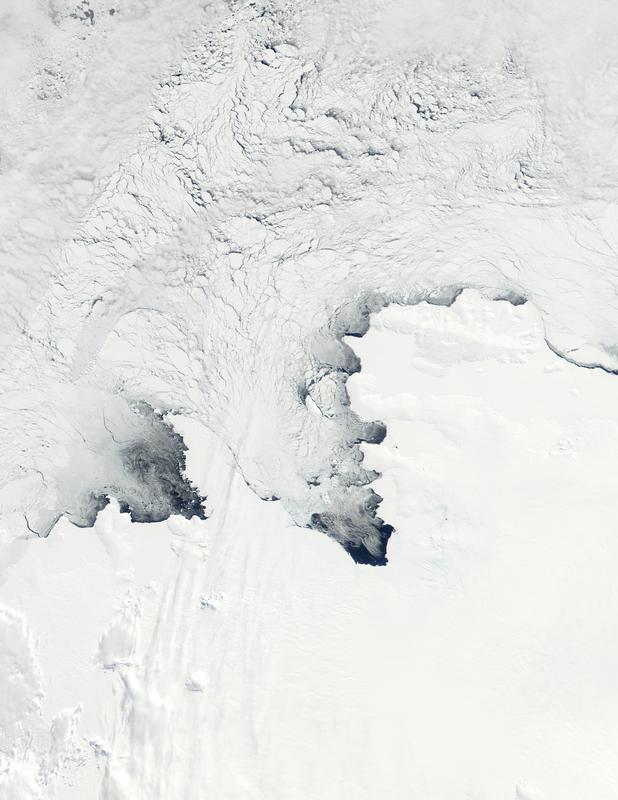More ice in a warming world

Cold southerly winds push sea ice away from the Antarctic coast, leading to new ice formation in the open water (polynya) along the coast. Satellite image by Terra-MODIS on October 23, 2001 Jacques Descloitres, MODIS Land Rapid Response Team, NASA/GSFC
In September 2014, Antarctic sea ice covered more than 20 million square kilometers for the first time since the beginning of continuous satellite measurements in 1979. This maximum extent continues an overall increase of Antarctic sea ice that has puzzled scientists and the general public alike, in particular given the ongoing overall warming of our planet that simultaneously causes Arctic sea ice to retreat rapidly.
In a new study published this week in Geophysical Research Letters, scientists from the Max Planck Institute for Meteorology (MPI-M) in Germany explain the underlying cause of the long-term Antarctic sea-ice increase and analyze why climate models fail to reproduce it. „There is primarily one thing you need to get right if you want to model Antarctic sea ice: The wind pattern“, explains Alexander Haumann, lead author of the new study.
„We are primarily talking about regions with winter-time temperatures far below freezing here, and even with the ongoing warming, there is still a lot of ice growth in the ocean around Antarctica. Forced by strong winds, this sea ice is sometimes transported over more than a thousand kilometers. So if you want to know where it goes and which area it covers, you need to understand how it's being pushed around by the winds. “
And these winds have changed over the past decades. „We see a stronger off-shore component of wind patterns in particular in the Ross Sea, which is the sector of Antarctica that opens towards the Pacific. There, the winds have changed such that they blow the ice further away from the coast where new ice continuously forms“, explains Haumann's colleague Dirk Notz who leads the Sea-ice research group at MPI-M. While this was suspected also by earlier studies, the new study now shows this relationship to play the main role in ice coverage until today. „Where the winds blow more strongly away from the Antarctic continent, the ice cover increases because the ice is further blown to the north and the ocean refreezes in the south. It's as simple as that. “
Two questions then of course remain: Why have the winds changed? And why do models not capture these changes? The new study addresses both these questions. „The changing wind patterns are caused by lower surface pressure in some areas around Antarctica. In our model simulations, we get such lower surface pressure if we include both the effect of the ozone hole and the increase in greenhouse gas concentration. The ozone hole cools the high atmosphere over Antarctica, while the greenhouse gases warm the lower atmosphere. In combination, this can explain a change of the wind pattern, but we’re not sure yet whether this is also the main driver of the changes in the real world.“, says Hauke Schmidt, who leads the Middle and Upper Atmosphere research group at MPI-M.
But even though the model simulates a lowering of the surface pressure, it does not get the ice increase. Also this the scientists now understand: They suspect that the model does not capture the influence of the smaller scale topography around the continent and surface processes over ice and snow accurately enough. These processes influence the surface-pressure distribution and hence the direction of the wind. “In our model, the pressure changes such that the wind primarily blows stronger parallel to the coast line rather than away from it. Once this is better represented in the model, we should get better simulations of the sea-ice trend”, concludes Haumann.
So the scientists have understood why the sea ice increases and why their model does not capture it. Now they work on improving the atmospheric circulation around the continent, trusting that this will eventually allow them to reproduce the observed sea-ice increase in their model. Then the puzzle of Antarctic sea ice would fully be solved.
Original Publication
Haumann, F.A., D. Notz, and H. Schmidt (2014), Anthropogenic influence on recent circulation-driven Antarctic sea-ice changes, Geophys. Res. Lett., doi: 10.1002/2014GL061659
Contact:
Dr. Alexander Haumann,
now at ETH Zurich,
Phone: +41 44 6325786
Email: alexander.haumann@usys.ethz.ch,
Dr. Dirk Notz
Max Planck Institute for Meteorology
Phone: +49 (0) 40 41173 163
Email: dirk.notz@mpimet.mpg.de
Dr. Hauke Schmidt
Max Planck Institute for Meteorology
Phone: +49 (0) 40 41173 405
Email: hauke.schmidt@mpimet.mpg.de
Media Contact
More Information:
http://www.mpimet.mpg.deAll latest news from the category: Earth Sciences
Earth Sciences (also referred to as Geosciences), which deals with basic issues surrounding our planet, plays a vital role in the area of energy and raw materials supply.
Earth Sciences comprises subjects such as geology, geography, geological informatics, paleontology, mineralogy, petrography, crystallography, geophysics, geodesy, glaciology, cartography, photogrammetry, meteorology and seismology, early-warning systems, earthquake research and polar research.
Newest articles

NASA: Mystery of life’s handedness deepens
The mystery of why life uses molecules with specific orientations has deepened with a NASA-funded discovery that RNA — a key molecule thought to have potentially held the instructions for…

What are the effects of historic lithium mining on water quality?
Study reveals low levels of common contaminants but high levels of other elements in waters associated with an abandoned lithium mine. Lithium ore and mining waste from a historic lithium…

Quantum-inspired design boosts efficiency of heat-to-electricity conversion
Rice engineers take unconventional route to improving thermophotovoltaic systems. Researchers at Rice University have found a new way to improve a key element of thermophotovoltaic (TPV) systems, which convert heat…



